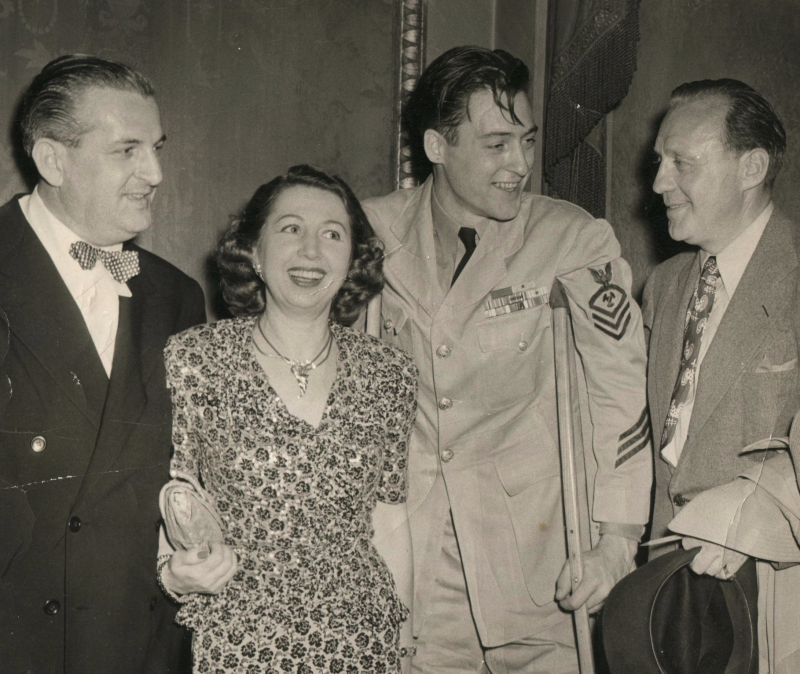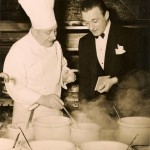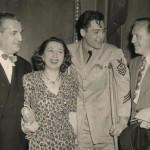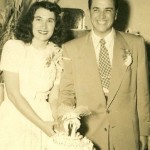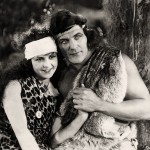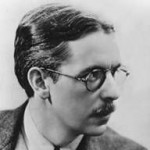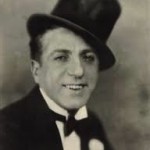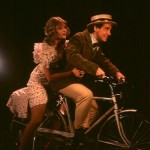by: Michael Elihu Colby
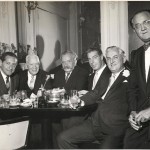
Louis Nizer, humorist Harry Herschfield, writer Konrad Bercovici, Joe DiMaggio, Ben B. Bodne, Abel Green
Upon moving into the Algonquin Hotel in 1946, the new owner—my grandfather Ben Bodne—oversaw 160 employees, far more than he’d ever supervised before. Among them were characters as colorful as the celebrities housed at the hotel.
Renowned writer Quentin Reynolds described a few such employees in his article “The Hotel That Refused to Die” (Esquire, February 1950 edition). There was switchboard operator Lovilla Bush, affectionately nicknamed “Bushy,” who reputedly could track down anyone from Gertrude Lawrence to Noel Coward to J. Edgar Hoover. Hotel regulars didn’t even have to feed her phone numbers—she had ways and means to find anyone. Also notable was Martin the Valet (Martin Stephen Kalydjian), who worked in an office resembling that of a Broadway agent, his walls filled with warmly inscribed photos of theatre luminaries. Maître d’ Raul (Raul Viarengo) was a backer of plays, to whom fellow investors often turned for advice on best bets.1 Raul was likewise a master strategist at solving daily dining dilemmas. When a guest found a fly in her salad, he popped it in his mouth, swallowed down the evidence, and exclaimed “Delicious! A raisin.” Another quick solution involved Mrs. Robert Bolt, who was staying at the hotel during the Broadway run of her husband’s hit play A Man For All Seasons. When she tried to enter the hotel’s Oak Room wearing slacks, Raul cautioned “We have a rule against women in slacks, but if you will permit me, I will supply you with a skirt—the same kind of skirt I once made for Tallulah Bankhead.” Thereupon, he draped a tablecloth around Mrs. Bolt’s waist, adjusted it, added a sash he fashioned from the pink silk ribbon of a candy box, and regally ushered Mrs. Bolt to a table.2
As Grandpa Ben learned, personal attention—as offered to guests by the hotel staff—was the lifeblood of the hotel’s longevity. Knowing names, habits, favorite rooms, and other details was essential to making visitors feel the Algonquin was a home away from home. But, in 1946, such cordiality couldn’t sweep the hotel’s state of disrepair under the moldy rug. Grandpa Ben had bought the hotel for just over a million dollars and rustled up another $300,000 for renovations. For eight months, he marshaled a covert mission to overhaul the hotel during late hours when no one would notice. According to the Quentin Reynolds’ article, “He sent three hundred chairs, divans, tables and beds to the city dump. But he replaced them with replicas of the old and no one noticed the difference. He had all of the halls and most of the rooms painted, but he stuck to the old colors.”3 Among other improvements, he replaced the antiquated kitchen equipment with optimum upgrades. In time, it was as if elves had impeccably dry-cleaned the place, so subtle yet thorough was the make-over. Grandpa said, “I was spending a fortune to make the guests more comfortable, but couldn’t let them find out. Don’t forget that many of them had been living off and on at the Algonquin for 20 years or more, and they wanted no changes.” 4
Grandpa had become a bona fide “Boniface:” the expression for innkeeper that often described past Algonquin owner Frank Case. Grandpa had proved a worthy successor. He liked to be called by the authoritative name Ben B. Bodne and loved using the initials B.B.B. on engravings (Though privately he admitted that he never really had a middle name and the “B” in Ben B. Bodne stood for “baloney”). He was the rare hotel owner who told his steward the bills for meat and other foods weren’t high enough! He wanted only the best meals at his hotel, still smarting from that salty boiled water that his mother called chicken soup.
He was a tireless worker, always looking for new ways to improve and modernize the Algonquin while retaining its Edwardian elegance. From the 1950s through the 1970s, he made the hotel a paradox: an old-fashioned hotel featuring new technology. Before they became commonplace, he installed such novelties as air conditioning and smoke detectors. He supplied the maids with walkie-talkies. He also made the Algonquin the first hotel in New York to use electronic key-cards. However, he insisted on one cozy concession to the past, employing an elevator man—when other hotel elevators were going automatic (Grandma Mary’s strong claustrophobia probably clinched the deal).
Busy as he was, he demanded time-out during the baseball season. No one was to disturb him when a ballgame was on radio and later TV. In fact, he often had two televisions playing—watching baseball, football, basketball and/or golf tournaments.
Meanwhile, the Algonquin was enjoying a Renaissance. The visitors not only included New York show people, but members of the U.S. Supreme Court, international filmmakers, musicians, novelists, and, of course, everyday civilians. The hotel’s three restaurants—the Rose Room, the Oak Room, and the Chinese Room—were hotspots for celebrity sightings.
The Blue Bar was a favorite haunt of Tennessee Williams, Norman Mailer, William Saroyan, and John Cheever. After Broadway openings, the Rose Room teemed with regulars including Helen Hayes, Douglas Fairbanks Jr., caricaturist Al Hirschfeld, Moss Hart, Kitty Carlyle, and Tallulah Bankhead (Bankhead—like Angela Lansbury—lived at the Algonquin, while still in her teens, on arriving in New York). Before openings, critics like George Jean Nathan, Walter Kerr, and H.L. Mencken would gather. Mencken called the hotel “The most comfortable hotel that I have ever found in America—and God knows I’ve seen a lot of them.” Visiting, as well, were original Round Tablers like Dorothy Parker, George S. Kaufman, Marc Connelly, and various Marx Brothers. To wit, the hotel remained the stomping ground of writers from New Yorker Magazine, including its editor Harold Ross and his successor William Shawn. In fact, Ross conceived the New Yorker there in 1925, during a poker game with illustrious writers.
Grandma Mary basked in the glitter and the glamour. Where else could she enter the elevator alongside William Faulkner and Thornton Wilder and introduce them, saying “Don’t you two boys know each other?” And what neighbors the Bodnes had! Every day was like a TV episode featuring great guest stars. Among the permanent Algonquin residents were Mr. and Mrs. James Thurber, composer Alec Wilder, and character actress Enid Markey (the screen’s first Jane—opposite Elmo Lincoln’s Tarzan—who by the 1950s looked more like Mrs. Santa Claus). For intellectual stimulation, there were the many playwrights docking at the hotel while working on a play: e.g. Arthur Miller, Tennessee Williams, Ben Hecht (The Front Page), and William Inge (Picnic).
As in Charleston, Grandma worked with Grandpa like a tag-team. She was the Will Rogers of hoteliers; she never met a guest she didn’t like (At least, early on). She continued the hotel’s tradition of personal service, detecting and catering to the preferences of her guests. Ingratiating herself with the theatre crowd, she soon became the go-to person for hard-to-get theatre tickets, indulging guests and her own relatives (who had either moved to the New York area or often vacationed there). Meanwhile, she and Grandpa Ben cultivated a group of stellar friends, including Joe DiMaggio, columnist Leonard Lyons, attorney Louis Nizer, Variety editor, Abel Green, Audrey Wood (agent of Tennessee Williams), and actor Dana Andrews (whose movie Laura was partly filmed at the Algonquin). My grandparents grew particularly fond of Ted and Adah Lewis, Ted being the entertainer famous for the phrase “Is Everybody Happy?” and the hit song “Me and My Shadow.” The childless Lewises would one day treat me like family.
Beyond the daily bustle, the Algonquin wasn’t a typical setting for the Bodnes to oversee their two daughters. As living quarters, they had reconstructed half of the 10th floor into one homey apartment. Younger daughter, teenager Barbara Ann, attended New York’s Calhoon School. Five years older, my mother Renee Mae stayed South at the University of Georgia—till a trip to NYC, whereupon she met Sidney Jack Colby, a freshman at New York University. It was hello Sidney, and goodbye Southland. They were both 18 at the time and married by age 20 in 1948. This was not a lavish Algonquin event, but a ceremony in a rabbi’s study, followed by a simple party at my grandparents’ apartment. My father Sidney was the younger of two sons born to Dora and Irving Cohen, who owned a tuxedo and bridal gown shop in Brooklyn. Needless to say, my father wore a wedding suit worthy of Beau Brummel.
My father had changed his name from Sidney Cohen while aspiring to be a radio broadcaster. Music, especially jazz, was his greatest joy. It seemed like a living fantasy when he visited the Algonquin and encountered musical celebrities, from Ted Lewis to Rosemary Clooney, Irving Berlin to Noel Coward, and ultimately a woman he idolized, Ella Fitzgerald.
In a photograph of their wedding day, my parents look like a gorgeous wedding cake couple. Regrettably, their marriage would become a bittersweet one. They were simply too young and ill prepared for years ahead. My porcelain pretty mother, pampered all her life by my grandparents, was unable to fend for herself. Meanwhile, instead of a radio announcer, my father became a manager at the Algonquin, jumping at the opportunity offered by Grandpa Ben, even though Sidney had no hotel training (But then again, neither had my Grandfather when he bought the place).
A proviso was for my father to first learn the ropes at the hotel, working in different departments—from the kitchen onward. With his Kirk Douglas cleft and dimples, coupled with a sunny personality, my father proved quite popular as manager. Through the years, according to my father, he had to deflect flirtations from such guests as Miriam Hopkins, Rona Barrett, and Michael Redgrave. My father wasn’t that captivated by celebrities, especially with my grandparents around.
The Colbys set up an apartment on Central Park West. My grandmother engaged a housekeeper to keep everything tidy. Though time would prove otherwise, the marriage seemed perfect—at least from afar. Within a few years, my mother was pregnant with the first of a new generation descended from Bodnes, Mazos, and Cohens. I was born in 1951, Michael Elihu Colby, named after Grandpa Ben’s father Michael Bodne and Grandma’s father Elihu Mazo.
Naming children after Elihu was a tradition in the Mazo family, so beloved was this man who often gifted groceries to the poor and needy in Charleston—regardless of background or color. Elihu’s generosity was likewise exemplified during a time when Grandpa Ben was financially strapped; Elihu handed him, unprompted, an envelope full of large bills for living expenses—for which Grandpa would be ever grateful. Among Elihu Mazo’s descendants, those named after him include an Elliot, Elinor, Eileen, Ellen, Eric and several Elihus: in probably one of the few families where you’ll still hear the name Elihu. This tradition has even influenced my writing: when I co-created with Paul Katz the musical Tales of Tinseltown, I named the lead characters Ellie Ash and Elmo Green.
Because of his kind heart and charity, Elihu Mazo was something of a celebrity in Charleston. Upon my birth, Michael Elihu Colby immediately had another celebrity connection. Right after delivery, the first people the Bodnes phoned were Ted and Adah Lewis. I can just imagine Ted Lewis responding, “Is everybody happy?” Every year, for as long as they lived, I received a birthday card and present from “Aunt Adah and Uncle Ted.” Uncle Ted Lewis even loaned me his signature top hat for a singing performance I gave of “Me and My Shadow.” (It’s no wonder that my favorite Abbott and Costello movie is Hold That Ghost, in which Ted Lewis was spotlighted.) I was deeply blessed to know many legendary figures through the years, as a kid visiting my grandparents at the Algonquin.
Next part: Screaming At Agnes Moorehead and Other Adventures
References
1 Reynolds, Quentin. “The Hotel That Refused to Die” in Esquire, New York. February, 1950.
2 Lyons, Leonard. “The Lyons Den,” N.Y. Daily Post, New York. November 30, 1961.
3 Reynolds, Quentin. Ibid.
4 Poe, Randall, “The Unicorn of Big-City Hotels…With Thurber, Parker, Benchley, Ross and company.” Travel and Leisure, New York. No date given.
*No copyright Infringement Intended. For Entertainment Purposes Only.
@ 2013, Michael Colby


